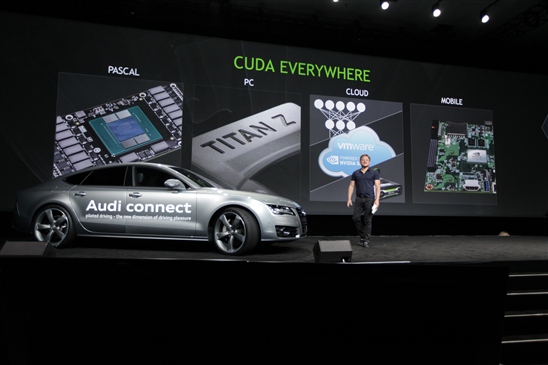The guy behind me in line wavered between decaf and regular coffee. He settled on full strength and justified his choice: “I barely slept last night; I’m so excited for this conference.”
We were at last week’s NVIDIA GPU Technology Conference in San Jose and I soon learned why he was so passionate. The conference showed cutting edge applications of how GPUs – graphical processing units capable of very efficiently manipulating computer graphics – push the boundaries of what is possible in visual computing. The examples ranged across multiple industries. In automotive, NVIDIA CEO Jen-Hsun Huang’s keynote featured an Audi that drove itself on stage, supported by an NVIDIA Tegra K1.
© 2014 NVIDIA Corporation. All rights reserved.
In the media space, the Pixar keynote showed how GPUs help give life to the hundreds of thousands of hairs on Sulley, a key character from the movie Monsters, Inc. In healthcare, we saw how Grateful Dead drummer Mickey Hart’s brain reacted while he performed wearing an Oculus Rift headset – demonstrating how virtual reality and gaming can be therapeutic in improving cognitive abilities.
These effects come from the massively parallel processing power of GPUs which can be embedded in Dell servers, workstations or even PCs to help accelerate applications. Dell was a diamond sponsor this year and we hosted sessions to share best practices around integrating GPUs in various forms.
Scott Hamilton from our Dell Precision Workstation team shared how the right system configuration can maximize productivity – and how productivity gains drive ROI. He also showed two application usage archetypes and how choosing the right CPU is important. For highly interactive applications such as modeling and manipulation, performance tends to scale with CPU frequency and/or GPU class. For highly computational models where you set up a model, load a data set and hit a button – performance tends to scale with CPU core count, frequency, cache and memory.
Onur Celebioglu from our HPC team walked through system design considerations for GPU-enabled HPC solutions. The typical goal that the Dell architects work to is a balanced design that maximizes ROI. Different form factors and their impact on density, memory and storage were shared, as well as two tools. NVIDIA has a tool that estimates many GPUs nodes are cost efficient for your use case – please contact your Dell or NVIDIA rep to access this tool as it is not publicly available. Dell has a tool that recommends an HPC solution based on your needs.
Gary Radburn from our Workstation Virtualization team shared several technology stacks for virtualized workstation solutions and showcased Dell’s new Virtual Workstation Center of Excellence. This CoE gives our customers onsite and/or remote access to virtual workstation solutions and Dell experts. This can help with both workflow development and proof of concepts.
The NVIDIA GTC conference woke me up to the possibilities of GPU-enabled technology. As I think back to last week, I think my stranger in the coffee line would have been just fine with the decaf option after all.

